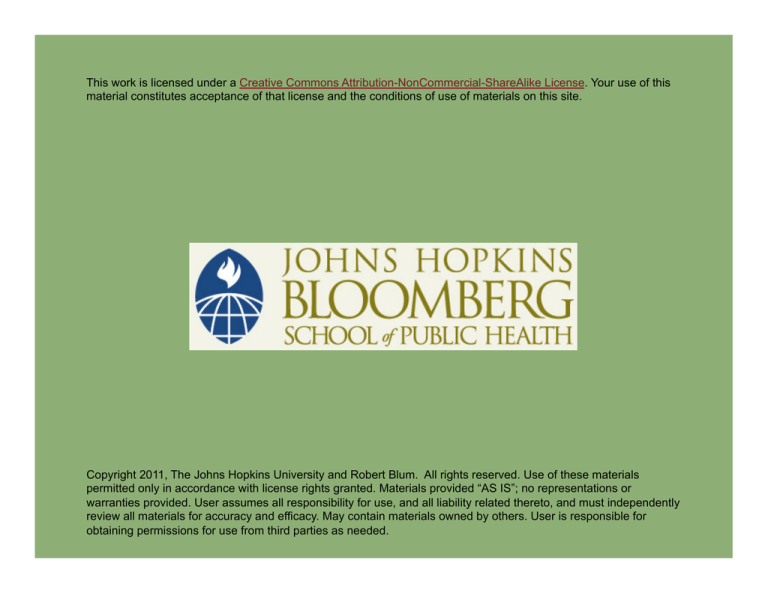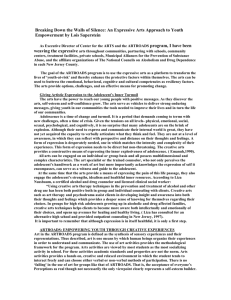
This work is licensed under a Creative Commons Attribution-NonCommercial-ShareAlike License. Your use of this
material constitutes acceptance of that license and the conditions of use of materials on this site.
Copyright 2011, The Johns Hopkins University and Robert Blum. All rights reserved. Use of these materials
permitted only in accordance with license rights granted. Materials provided “AS IS”; no representations or
warranties provided. User assumes all responsibility for use, and all liability related thereto, and must independently
review all materials for accuracy and efficacy. May contain materials owned by others. User is responsible for
obtaining permissions for use from third parties as needed.
Section B
Positive Youth Development as a Strategy to Improve Youth
Health
Resiliency
Resiliency: the capacity to recover and maintain adaptive
behavior after insult
3
Risk Factors
Risk factors refer less to outcome behaviors (for example,
risk-taking) and more to factors that limit the likelihood of
successful development
4
Stress
Stress is the personal interpretation and subjective
experience of risk
5
Stress
Stress is influenced not only by the event but the meanings
an individual ascribes to it
6
Resiliency and Competency
Resiliency and competency are central themes of positive
youth development
7
Resilience
The construct of resilience is closely linked with prevention
8
Positive Youth Development
Positive youth development is defined as participating in
pro-social behaviors and avoiding health-compromising and
future-jeopardizing behaviors
9
Tenet of Positive Youth Development
Positive youth development has as a basic tenet:
- Youth are resources to be developed—not problems to
be fixed
Source: Pittman
10
Youth Development Approaches
Youth development
approaches focus on:
- Improving
adolescent
knowledge,
attitudes, norms,
skills
- Preparing young
people for adult life
Photo source: http://www.census.gov/pubinfo/www/broadcast/photos/index.html
11
Predispositions to Risk; Protection from Harm
What do we know about what predisposes to risk, and what
protects young people from harm?
12
Connections Count
Parent and family
connections
School
connections
Peer connections
Photo source: http://www.census.gov/pubinfo/www/broadcast/photos/index.html
13
School Counts
School
achievement
School
involvement
School climate
Photo source: http://www.census.gov/pubinfo/www/broadcast/photos/index.html
14
Education Is a Component of Positive Youth Development
In developing countries, the strong association between
schooling and positive outcomes has been well described
There is a strong, inverse relationship between education and
number of children
Academic performance is inversely correlated with every risk
factor of adolescence
As education goes up, cigarette-smoking declines
15
Parents Count
Parent availability
Parent expectations
for school
performance
Parent values
Photo source: http://www.census.gov/pubinfo/www/broadcast/photos/index.html
16
Fewer Protective Factors
Young people who are “at risk” for health-jeopardizing
behaviors and outcomes have:
- Higher exposure to risk-predisposing risk factors
- Fewer protective factors than peers
17
Protective Factors Moderate Risk
Increasing protective factors does not eliminate risk
- It moderates it
18
A Positive Youth Development Framework
A positive youth development framework provides:
- Safety and structure
- Belonging and group membership
- Self-worth and contributions
- Independence and control over one’s life
- Competence
- Closeness with peers and nurturing adults
Source: Kirby and Coyle
19
Requirements for the Healthy Development of Youth
Participate as citizens
- As members of a household
- As workers
- As members of the neighborhood and larger community
Gain experience in decision making
Interact with peers and acquire a sense of belonging
Reflect on self in relation to others and discover self by
looking outward as well as inward
Source: G. Konopka, 1993
20
Requirements for the Healthy Development of Youth
Discuss conflicting values and formulate their own value
systems
Experiment with their own identity, with relationships to
other people, with ideas
- Try out various roles without having to irrevocably
commit to any
Develop a feeling of accountability in the context of a
relationship among equals
Cultivate a capacity to enjoy life
Source: G. Konopka, 1993
21
The Five Ps that Promote Development
1. Possibilities and preparation
- Development is linked to the range and quality of
appropriately challenging and supportive opportunities
for exploration, learning, and individual growth
2. Participation
- Engagement and active involvement of young people
3. People
- Engagement is mediated through people
- Relationships are key
Source: Pittman and Zelden, 1995
22
The Five Ps that Promote Development
4. Place and pluralism
- Development occurs within and is profoundly influenced
by contexts
- Environments have physical, social, cultural, and
philosophical dimensions
5. Partnerships
- Development requires partnerships among players
Youth, family, service providers, and community
Source: Pittman and Zelden, 1995
23
Institutions and Youth Development
Five aspects of institutions that enhance youth development
1. Provide youth choices and control over things that affect
their lives
2. Have a safe place to be themselves
3. Be treated with dignity and respect
4. Have access to relationships that create connections and
connectedness
5. Be surrounded by hope and promise
Source: Berry, 1995
24
PCAP Model
P eople: an adult who cares, who is
connected; a network of adults
involved in the life of the adolescent
P
C ontributions: the
opportunities to
contribute to family,
neighborhood,
community, youth
involvement
C
A
P lace: a place
P
A
A ctivities: school and community
activities that develop a sense of
connection/belonging
where youth can
congregate to
recreate (with adult
supervision) to
develop friendships
The
Adolescent
25





